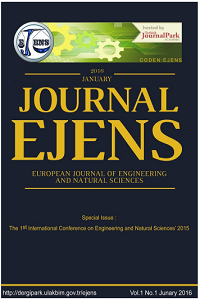Removal of Ammonium Nitrogen from the DAF-Pretreated Poultry Slaughterhouse Wastewater by Lemna minor
Removal of Ammonium Nitrogen from the DAF-Pretreated Poultry Slaughterhouse Wastewater by Lemna minor
Lemna minor (duckweed),
___
- [1]. (2016) Webpage on Republic of Turkey Ministry of Food, Agriculture and Livestock, (online): available: https://www.tarimorman.gov.tr/Konular/Hayvancilik/Kanatli-Yetistiriciligi TÜRKİYE VE DÜNYADA KANATLI SEKTÖRÜNÜN GENEL DURUMU-2018.doc[2]. Quinn J.M. and McFarlene P.N., “Effects of Slaughterhouse and Dairy Factory Wastewaters on Epilithon: a Comparison in Laboratory Streams”, Water Research, Vol.23(10), pp. 1267–1273, 1989.[3]. Sandogoyin A.D and Agbawhe O.M., “Environmental Study on Surface and Ground Water Pollutants from Slaughterhouse Effluents”, Bioresource Technology, Vol.41, pp.193–200, 1992.[4]. Bull M.A. , Sterritt R.M. , Lester J.N. ,“The Treatment of Wastewaters from the Meat Industry: a Review”, Environ. Technol. Lett., 3, pp. 117–126, 1982.[5]. Tritt W.P. and Schuchardt F., “Materials Flow and Possibilities of Treating Liquid and Solids from Slaughterhouses in Germany”, Bioresour. Technol., Vol.41, pp. 235–245, 1992.[6]. Masse D. and Masse L., “The Effect of Temperature on Slaughterhouse Wastewater Treatment in Anaerobic Sequencing Batch Reactors”, Bioresource Technology, Vol.76 (2), pp. 91–98, 2000.[7]. Körner S. and Vermaat, J.E., “The Relative Importance of Lemna Gibba L., Bacteria and Algae for the Nitrogen and Phosphorus Removal in Duckweed-Covered Domestic Wastewater”, Water Res., Vol.32 (12), pp. 3651–3661, 1998.[8]. Yılmaz Z., Gür K. ve Tarlan E., “Atıksularının Karakterizasyonu ve Su Mercimeği ile Arıtılabilirliği”, S.Ü.Müh.-Mim.Fak.Dergisi, Cilt: 20, Sayı:4, Konya, 2005.[9]. Oron, G. vd., “Performence of the Duckweed Species Lemna gibba on Municipal Wastewater for Effluent Renovation and Protein Production”, Biotech. And Bioeng., Vol.29 (2), pp. 258–268, 1987. [10]. Mandi L., “Marrakesh Wastewater Purification Experiment Using Vascular Aquatic Plants Eichhornia crassipes and Lemna gibba”, Water Science and Technology, Vol.29 (4), pp. 283–287, 1994.[11]. Gürtekin E., Şekerdağ N., “Son Çökeltme Havuzlarında Su mercimeğinin (Lemna Minor L.) Rolü”, SAÜ. Fen Bilimleri Dergisi, Cilt:12 (1), Syf: 28–31,Elazığ, 2008.[12]. American Public Health Association (APHA), Standard Methods for the Examination of Water and Wastewater, 21st Ed., Washington, DC, 2005.
- Başlangıç: 2015
- Yayıncı: CNR Çevre
Yahya BOZKURT, Adnan TÜRKER, Gamze SOYTEMİZ, Serdar SALMAN
Generation of a Multi-Layered Diffusion Coating on an Interstitial-Free Steel
Fikri Erdem Şeşen, Ömer Serdar Özgen
Kinetics of Granulated Waste Tyre Pyrolysis via Thermogravimetry and Model-Free Methods
Peter T. CHEROP, Sammy L. KİAMBİ, Paul MUSONGE
Development of Ecological Biodesign Products by Bacterial Biocalcification
Tuğba Keskin Gündoğdu, İrem DENİZ, Alpcan ARİC, Burak Talha YILMAZSOY, Ozge ANDİC CAKİR, Aysegul ERDOGAN, Didem ALTUN, Ayca TOKUC, Burcu Filiz DEMİRCİ, Aylin SENDEMİR, Gulden KOKTURK, Feyzal Ozkaban
Wastewater Treatment by Floating Macrophytes (Salvinia Natans) Under Algerian Semi-Arid Climate
Laabassi AYACHE, Boudehane ASMA
Developments and Applications in Enzyme Activated Membrane Reactors
Nadir DİZGE, Ruken Esra DEMİRDOGEN, Kasım OCAKOGLU
Investigation of Notch Root Strain Behaviors Under Combined Loadings
Toros Arda AKSEN, Emre ESENER, Mehmet FIRAT
Koray KARABULUT, Dogan Engin ALNAK, Ferhat KOCA
Determination of The Hip Stem Loosening Using Vibration Method
